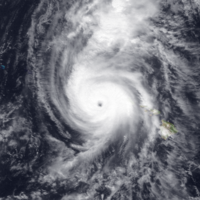Hurricane Edith: Difference between revisions
(→Impact) |
|||
| Line 81: | Line 81: | ||
In Marivista ----- | In Marivista ----- | ||
Janapa's southern coasts saw light flooding and high winds, as the outer bands of Edith skimmed the islands. Despite dodging the brunt of the storm, significant tree loss occurred across Janapa, winds brought down power lines, and a storm surge of 2 meters was observed in [[Sittusand]], sweeping away vehicles and inundating the tourist town. 4 people were killed in Janapa, one as a result of the storm surge and three as a result of debris impact. President [[Kendrick Mehans]] ordered the activation of the Janapan military to assist Lower Aseu and Marivista in recovery efforts after the storm. | |||
===Zamastan=== | ===Zamastan=== | ||
Revision as of 22:46, 3 September 2023
| Category 5 hurricane | |
|---|---|
 Edith at peak strength over Lower Aseu on September 3rd. | |
| Formed | August 29, 2023 |
| Winds | 1-minute sustained: 295 km/h (185 mph) |
| Pressure | 919 hPa (mbar); 27.14 inHg |
| Areas affected | Lower Aseu, Marivista, Janapa, Ossinia Southwestern Zamastan |
Hurricane Edith is an ongoing Cantalle hurricane. It is the fifth named storm and second hurricane of the 2023 hurricane season. Edith originated from a vigorous tropical wave off the coast of Adula that was first identified by ZOAC on August 29th, 2023. The tropical wave gradually became more organized and obtained gale-force winds on August 30th before organizing into Tropical Storm Edith. On the 31st, Edith strengthened into a Category 1 hurricane, reaching an initial peak of 85 mph (137 km/h), with a minimum central pressure of 987 mbar (hPa; 29.15 inHg). It rapidly intensified, gaining Category 2 strength on September 1st around noon, Category 3 by the early morning of September 2nd, and it became a Category 4 with 145 mph (230 km/h) winds by its landfall in Marivista around noon that day. On September 3rd as it barreled across the Ossinia Sea, Edith became a Category 5 and peaked at 185 mph (295 km/h), making it the third-most powerful hurricane ever observed in the Cantalle Ocean after Elnora (1999) and Janae (2011).
Meteorogical history
Preparations
Northern Cantalle Islands
Marivista
On August 30th, the government of Marivista mobilized 200 members of the Federal Marivistan National Guard in order to assist with evacuations and preparations, along with possible search and rescue operations for the storm's aftermath. The following day, the government of Marivista declared a national state of emergency and issued hurricane warnings across the entire federation. Prime Minister Wayan Blechynden ordered mandatory evacuations for the southernmost islands, where the major city of Laufrier was located, leaving behind a few hundred inhabitants who decided to stay. Just hours before the storm mad landfall, as the outer bands began to affect the islands, the government of Marivista issued a warning to take immediate cover, stating that those who do not heed the warning may very well "lose their lives".
Lower Aseu
President Salma Vargés issued a state of emergency for Lower Aseu on August 31st and ordered evacuations along the southwestern coastal regions.
Zamastan
On August 31st, Matthew Lockbeer, Director of the Zamastanian Oceanic and Atmospheric Center, classified Edith's rapid development in the central Cantalle as a "late season intense storm" with the potential to bring catastrophic winds, rain, flooding, and general disaster to the region if preparations weren't adaquetely followed. Alenchon Governor Peter Younggrain advised evacuations of coastal communities in anticipation of the hurricane's projected path, though most forecasts had it on a course towards the Tregueux/Landeda provincial borders for a mainland landfall. Governor Morriane Wilkons of Tregueux issued a state of emergency for the province, as did Landeda provincial governor Marcus Sommerson Jr.. President Sabine Armitage advised citizens in the projected impact zones to heed the authority of local officials as Edith intensified.
Impact
| Country | Deaths |
|---|---|
| Number TBA | |
| Number TBA | |
| Number TBA | |
| 4 | |
| Total | TBA |
Northern Cantalle Islands
The combined effects of the precursor low to Edith and a disturbance over the Cantalle Ocean caused significant flooding across the impacted Northern Cantalle Islands.
In Lower Aseu, torrential rain caused at least three rivers to overtop their banks. The southern and most populated island of Manley was hardest hit, with an estimated 344 people being killed in storm surges and collapsed buildings. The city of Samuelton reported a 12-foot (3.65 meter) storm surge, which laped over the seawall and beachheads, inundating the lowerlying areas, and washed away roads and power lines. Electricity across the Asueans was completely knocked out by the storm, with spared communities forced to use backup generators and collect rainwater. President Vargés said on September 3rd "without a doubt, despite our preparations, this is the costliest natural disaster in our nation's history. Our preparations insured that this catastrophe was not apocalyptic, but nevertheless this is a devastating and extremely costly storm which has happened."
In Marivista -----
Janapa's southern coasts saw light flooding and high winds, as the outer bands of Edith skimmed the islands. Despite dodging the brunt of the storm, significant tree loss occurred across Janapa, winds brought down power lines, and a storm surge of 2 meters was observed in Sittusand, sweeping away vehicles and inundating the tourist town. 4 people were killed in Janapa, one as a result of the storm surge and three as a result of debris impact. President Kendrick Mehans ordered the activation of the Janapan military to assist Lower Aseu and Marivista in recovery efforts after the storm.
Zamastan
In Zamastan ----